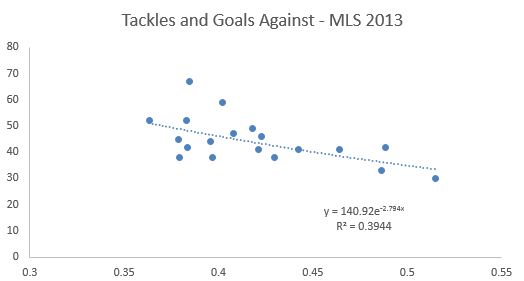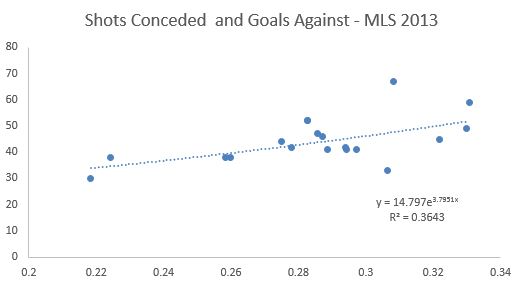In the wake of Major League Baseball awarding its MVP to Miguel Cabrera, debates over what "valuable" means have once again flared up. Though soccer and baseball are two incredibly different sports, I think we can apply some of the same logic to both MVP discussions. Major League Soccer has about two weeks remaining before its MVP award is handed out, and we will no doubt encounter many of the same controversies in the soccer blogosphere that appear in baseball every season.
The MVP controversy usually begins with what "valuable" means. I think there's little doubt in most people's minds that "valuable" and "skilled" are correlated. The main controversy is how correlated. To some, asking who was the best player in Major League Soccer in 2013 would be equivalent to asking who was the most valuable to his team. To others, there would be some key distinctions, the most common of which is that MVPs must come from teams that reach the post season.
In retort to that thinking, some very astute commenters in a Fangraphs.com forum offered up these nuggets. Hendu for Kutch made the analogy:
"We each want to buy something that costs $1. I’ve got a quarter, 8 nickels, and 10 pennies. My 'team' of coins is worth 75 cents and falls short of being able to buy the item. You have one dime and 18 nickels. Your 'team' is worth $1, and you successfully buy the item. Is your dime more valuable than my quarter simply because it led to a successful item purchase?"
Mike Trout = quarter and Miguel Cabrera = dime, for those of you not so into baseball, and the question is a good one. Few would argue that the dime is more valuable than the quarter just because it found itself in a position to help buy that scrumptious Twix.
In reply to someone arguing that the quarter had no value because it didn't lead to the purchase of a desired item, BIP and ndavis910 then chimed in:
"Except not everything costs $1, and at any rate, you would always choose the quarter over the dime when accumulating money for a purchase."
"Especially when you don’t know the cost of the items until you get to the store. In baseball, a team cannot be sure how many wins it will take to reach the playoffs until the last day of the season. In your example, the quarter is the most valuable piece regardless of whether or not the item cost $1 or $0.75."
When thinking about attributing value to players like Marco Di Vaio, Mike Magee, Camilo Sanvezzo, Robbie Keane and company, why should it matter where their teams finished? If one believes that Magee, for instance, is the best player in MLS, then does it matter if he took his team from 39 points to 49, versus from 40 points to 50? Either way, it's still ten points of value in the standings. When Magee was traded to Chicago, neither Chicago nor Magee knew that the Fire was going to need 50 points to make the playoffs. The fact that they got just 49 points shouldn't negate any of Magee's value.
If you say that it matters because MLS clubs get real value from extra playoff games, then think about this. Playoff cutoff lines are quite arbitrary. If MLS allowed only the top two teams in from each conference---not completely unreasonable for a league of just 19 teams---then none of the players mentioned above would be considered under this playoffs requirement. Playoffs represent an arbitrary bar that the players competing for the award don't get to set, and while reaching the playoffs does bring the team measurable revenue and value, basing an award on something outside an individual's control would, in my opinion, strip the award of its intended meaning and purpose.
Now let's anticipate the logical counterargument---that players pick up their games in playoff races and play well when it matters most.
For a moment, let's ignore the fact that little evidence has ever been found in professional sports that players can turn it on and turn it off as needed. This past season, Magee scored seven goals in Chicago's final nine games, a stretch in which the team averaged 1.56 points per match. That represents a pace that would have gotten the Fire into the playoffs if maintained for the entire season. Di Vaio scored five goals in his last 10 games---I even included that tenth-to-last game in which he scored two goals---in a stretch where Montreal tallied just 0.7 points per match, limping into the playoffs on a tie-breaker with Chicago. Just because one team makes the playoffs doesn't mean its best player was at his peak when it mattered. Goals are, admittedly, a narrow-minded way to measure a striker's value, but I think the point is still valid.
For me, the Magee-Di Vaio example above may have been no more than an exercise in confirmation bias. I chose to see what I already believed. However, the logic behind the belief that team standings shouldn't matter to players' MVP merits is still good stuff, and transcends any biased example I can come up with.
If we're ready to agree that that the MVP award should essentially be given to the best overall player, then we still have a tall task ahead of us. How do we measure skill on the soccer field? That is the 64,000-dollar question, and one we hope to help tackle here at ASA some day. But perhaps it's not so crazy to think that a guy like Federico Higuain is deserving of the MVP award. If you scoff at that notion, you likely do so because you've been trained to think about MVP awards in a certain way.
We're all about re-thinking things around here.












